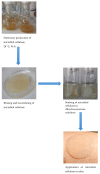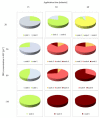Study on the Use of Microbial Cellulose as a Biocarrier for 1,3-Dihydroxy-2-Propanone and Its Potential Application in Industry
- PMID: 30966473
- PMCID: PMC6415240
- DOI: 10.3390/polym10040438
Study on the Use of Microbial Cellulose as a Biocarrier for 1,3-Dihydroxy-2-Propanone and Its Potential Application in Industry
Abstract
Can microbial cellulose (MC) be used as a bio-carrier for 1,3-dihydroxy-2-propanone (DHA)? The aim of this study was to examine the possibility of using MC as a biomaterial for DHA transferring into the stratum corneum and inducing changes in skin color. The MC patches were obtained from Gluconacetobacter xylinus strain and incubated in solutions with various concentrations of DHA (g·L-1: 20; 50; 80; 110) at 22 °C for 24 h. Afterwards; the patches were applied onto the skin for 15, 30, or 60 min. Skin color changes were assessed visually compared to a control patches without DHA. The intensity of skin color was increasing with the increase of DHA concentration and time of patches application. Application of MC patches with DHA (50 g·L-1) for 30 min ensured the color which was considered the closest to the desired natural tan effect. MC patches containing DHA can be biocarriers enabling DHA transport into the stratum corneum and causing skin color changes. Study results indicate a new possibility for industrial applications of MC; e.g., as a biocarrier in masking the symptoms of vitiligo or production of self-tanning agents in the form of masks.
Keywords: bacterial cellulose; biocarrier; biomaterial; dihydroxyacetone; microbial cellulose; vitiligo.
Conflict of interest statement
The authors declare no conflict of interest.
Figures






Similar articles
-
Tonality of suntan vs sunless tanning with dihydroxyacetone.Skin Res Technol. 2000 Nov;6(4):199-204. doi: 10.1034/j.1600-0846.2000.006004199.x. Skin Res Technol. 2000. PMID: 11428958
-
A colorimetric comparison of sunless with natural skin tan.PLoS One. 2020 Dec 14;15(12):e0233816. doi: 10.1371/journal.pone.0233816. eCollection 2020. PLoS One. 2020. PMID: 33315862 Free PMC article.
-
Self-tanning lotions: are they a healthy way to achieve a tan?Am J Clin Dermatol. 2002;3(5):317-8. doi: 10.2165/00128071-200203050-00003. Am J Clin Dermatol. 2002. PMID: 12069637
-
In search of the perfect tan: Chemical activity, biological effects, business considerations, and consumer implications of dihydroxyacetone sunless tanning products.J Cosmet Dermatol. 2023 Jan;22(1):79-88. doi: 10.1111/jocd.14968. Epub 2022 Apr 21. J Cosmet Dermatol. 2023. PMID: 35384270 Free PMC article. Review.
-
Dihydroxyacetone: A Review.J Drugs Dermatol. 2018 Apr 1;17(4):387-391. J Drugs Dermatol. 2018. PMID: 29601614 Review.
Cited by
-
Draft Genome Sequence of a Potential Commercial Biocellulose Producer, Strain Komagataeibacter europaeus GH1.Microbiol Resour Announc. 2020 Oct 15;9(42):e00963-20. doi: 10.1128/MRA.00963-20. Microbiol Resour Announc. 2020. PMID: 33060274 Free PMC article.
-
Better under stress: Improving bacterial cellulose production by Komagataeibacter xylinus K2G30 (UMCC 2756) using adaptive laboratory evolution.Front Microbiol. 2022 Oct 12;13:994097. doi: 10.3389/fmicb.2022.994097. eCollection 2022. Front Microbiol. 2022. PMID: 36312960 Free PMC article.
-
Antibacterial Activity of Biocellulose with Oregano Essential Oil against Cronobacter Strains.Polymers (Basel). 2020 Jul 24;12(8):1647. doi: 10.3390/polym12081647. Polymers (Basel). 2020. PMID: 32722062 Free PMC article.
-
Bacterial Nanocellulose toward Green Cosmetics: Recent Progresses and Challenges.Int J Mol Sci. 2021 Mar 11;22(6):2836. doi: 10.3390/ijms22062836. Int J Mol Sci. 2021. PMID: 33799554 Free PMC article. Review.
-
Exploring K2G30 Genome: A High Bacterial Cellulose Producing Strain in Glucose and Mannitol Based Media.Front Microbiol. 2019 Jan 30;10:58. doi: 10.3389/fmicb.2019.00058. eCollection 2019. Front Microbiol. 2019. PMID: 30761107 Free PMC article.
References
-
- Moosavi-Nasab M., Yousefi M. Biotechnological production of cellulose by Gluconacetobacter xylinus from agricultural waste. Iran J. Biotechnol. 2011;9:94–101.
-
- Ramachandran S., Fontanille P., Pandey A., Larroche C. Gluconic Acid: Properties, Applications and Microbial Production. [(accessed on 22 March 2018)];Food Technol. Biotechnol. 2006 44:185–195. Available online: http://www.ftb.com.hr/index.php/archives/80-volume-44-issue-no-2/447.
LinkOut - more resources
Full Text Sources

